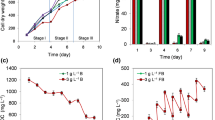Abstract
Design dark fraction reflects the unlit part of a microalgal culture system, as for example a hydraulic loop used for temperature or pH regulation, or a circulating pump for mixing purposes. This study investigates the impact of design dark fraction on photosynthetic biomass productivity of the eukaryotic microalgae Chlorella vulgaris. The effect of the volume of the dark fraction and the residence time spent in this dark fraction was investigated with two different nitrogen sources (N–NH4+, N–NO3−). Results showed a decrease of biomass productivity when the volume of the dark fraction and the dark residence time increased. Up to 47% loss of biomass productivity could be reached for a design dark fraction \(f_{\text{d}}\) = 30% of the total culture system volume. This loss was explained as a result of metabolic reactions related to an increase of respiration activity or a decrease of photosynthetic activity in the cells.



Similar content being viewed by others
References
Béchet Q, Shilton A, Guieysse B (2013) Modeling the effects of light and temperature on algae growth: state of the art and critical assessment for productivity prediction during outdoor cultivation. Biotechnol Adv 31(8):1648–1663. https://doi.org/10.1016/j.biotechadv.2013.08.014
Beijerinck MW (1890) Culturversuche mit Zoochlorellen, Lichenengonidien und anderen niederen Algen. Botanische Zeitung 47:725–739, 741–754, 757–768, 781–785
Bold HC (1949) The morphology of Chlamydomonas chlamydogama, Sp. Nov. Bull Torrey Bot Club 76(2):101–108. https://doi.org/10.2307/2482218
Blanken W, Magalhães A, Sebestyén P, Rinzema A, Wijffels RH, Janssen M (2017) Microalgal biofilm growth under day-night cycles. Algal Res 21:16–26
Cornet J-F, Dussap C-G (2009) A simple and reliable formula for assessment of maximum volumetric productivities in photobioreactors. Biotechnol Prog 25(2):424–435. https://doi.org/10.1002/btpr.138
Cornet J-F, Dussap CG, Gros J-B (1998) Kinetics and energetics of photosynthetic micro-organisms in photobioreactors. In: Scheper T (ed) Bioprocess and algae reactor technology, apoptosis. Advances in biochemical engineering biotechnology. Springer, Berlin, pp 153–224. https://doi.org/10.1007/BFb0102299
Graham PJ, Nguyen B, Burdyny T, Sinton D (2017) A penalty on photosynthetic growth in fluctuating light. Sci Rep 7:12513. https://doi.org/10.1038/s41598-017-12923-1
Janssen M (2002) Cultivation of microalgae: effect of light/dark cycles on biomass yield. 2002. Thèse de Doctorat. Université de Wageningen
Kandilian R, Pruvost J, Artu A, Lemasson C, Legrand J, Pilon L (2016) Comparison of experimentally and theoretically determined radiation characteristics of photosynthetic microorganisms. J Quant Spectrosc Radiat Transf 175(mai):30–45. https://doi.org/10.1016/j.jqsrt.2016.01.031
Kim G, Mujtaba G, Lee K (2016) Effects of nitrogen sources on cell growth and biochemical composition of marine chlorophyte Tetraselmis sp. for lipid production. Algae 31:257–266
Kliphuis AMJ, Janssen M, van den End EJ, Martens DE, Wijffels RH (2011) Light respiration in chlorella sorokiniana. J Appl Phycol 23(6):935–947. https://doi.org/10.1007/s10811-010-9614-7
Podevin M, De Francisci D, Holdt SL, Angelidaki I (2015) Effect of nitrogen source and acclimatization on specific growth rates of microalgae determined by a high-throughput in vivo microplate autofluorescence method. J Appl Phycol 27(4):1415–1423. https://doi.org/10.1007/s10811-014-0468-2
Pruvost J, Cornet JF, Le Borgne F, Goetz V, Legrand J (2015) Theoretical investigation of microalgae culture in the light changing conditions of solar photobioreactor production and comparison with cyanobacteria. Algal Res 10:87–99. https://doi.org/10.1016/j.algal.2015.04.005(juillet)
Pruvost J, Le Borgne F, Artu A, Legrand J (2017) Development of a thin-film solar photobioreactor with high biomass volumetric productivity (AlgoFilm©) based on process intensification principles. Algal Res 21:120–137. https://doi.org/10.1016/j.algal.2016.10.012(janvier)
Pruvost J, Cornet J (2012) Knowledge models for the engineering and optimization of photobioreactors. In: Posten C, Walter C (eds) Microalgal biotechnology: potential and production. Walter de Gruyter, Berlin, pp 181–224
Pruvost J, Le Borgne F, Artu A, Cornet J-F, Legrand J (2016) Chapter five—industrial photobioreactors and scale-up concepts. In: Legrand J (ed) Advances in chemical engineering. Photobioreaction engineering, vol 48. Academic Press, Cambridge, pp 257–310
Richmond A (2004) Handbook of microalgal culture: applied phycology and biotechnology, 2nd edn. Blackwell science, Hoboken
Ritchie RJ (2006) Consistent sets of spectrophotometric chlorophyll equations for acetone, methanol and ethanol solvents. Photosynth Res 89(1):27–41. https://doi.org/10.1007/s11120-006-9065-9
Sanz-Luque E, Chamizo-Ampudia A, Llamas A, Galvan A, Fernandez E (2015) Understanding nitrate assimilation and its regulation in microalgae. Front Plant Sci. https://doi.org/10.3389/fpls.2015.00899(octobre)
Souliès A, Legrand J, Marec H, Pruvost J, Castelain C, Burghelea T, Cornet J-F (2016) Investigation and modeling of the effects of light spectrum and incident angle on the growth of Chlorella vulgaris in photobioreactors. Biotechnol Prog 32(2):247–261. https://doi.org/10.1002/btpr.2244
Sueoka Noboru (1960) Mitotic replication of deoxyribonucleic acid in Chlamydomonas reinhardtii. Proc Natl Acad Sci USA 46(1):83–91
Takache H, Pruvost J, Cornet J-F (2012) Kinetic modeling of the photosynthetic growth of Chlamydomonas reinhardtii in a photobioreactor. Biotechnol Prog 28(3):681–692. https://doi.org/10.1002/btpr.1545
Takache H, Pruvost J, Marec H (2015) Investigation of light/dark cycles effects on the photosynthetic growth of Chlamydomonas reinhardtii in conditions representative of photobioreactor cultivation. Algal Res 8:192–204. https://doi.org/10.1016/j.algal.2015.02.009(mars)
Terry KL (1986) Photosynthesis in modulated light: quantitative dependence of photosynthetic enhancement on flashing rate. Biotechnol Bioeng 28(7):988–995. https://doi.org/10.1002/bit.260280709
Torzillo G, Seibert M (2013) Hydrogen production by Chlamydomonas reinhardtii. In: Richmond A, Hu Q (eds) Handbook of microalgal culture: applied phycology and biotechnology, 2nd edn. Wiley, Oxford, pp 417–432
Acknowledgements
This research did not receive any specific grant from funding agencies in the public, commercial, or not-for-profit sectors.
Author information
Authors and Affiliations
Corresponding author
Ethics declarations
Conflict of interest
The authors declare that they have no conflict of interest.
Additional information
Publisher's Note
Springer Nature remains neutral with regard to jurisdictional claims in published maps and institutional affiliations.
Rights and permissions
About this article
Cite this article
Kazbar, A., Marec, H., Takache, H. et al. Effect of design dark fraction on the loss of biomass productivities in photobioreactors. Bioprocess Biosyst Eng 43, 207–216 (2020). https://doi.org/10.1007/s00449-019-02217-3
Received:
Accepted:
Published:
Issue Date:
DOI: https://doi.org/10.1007/s00449-019-02217-3




